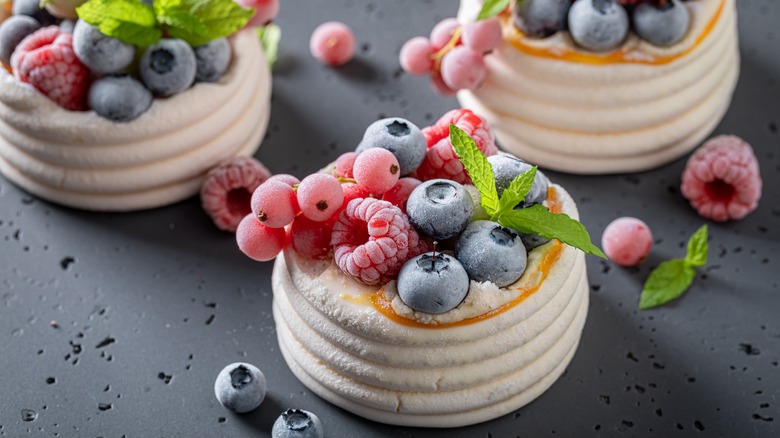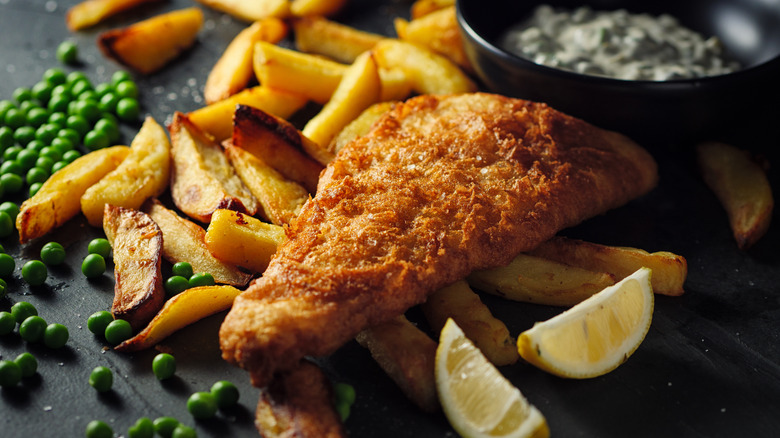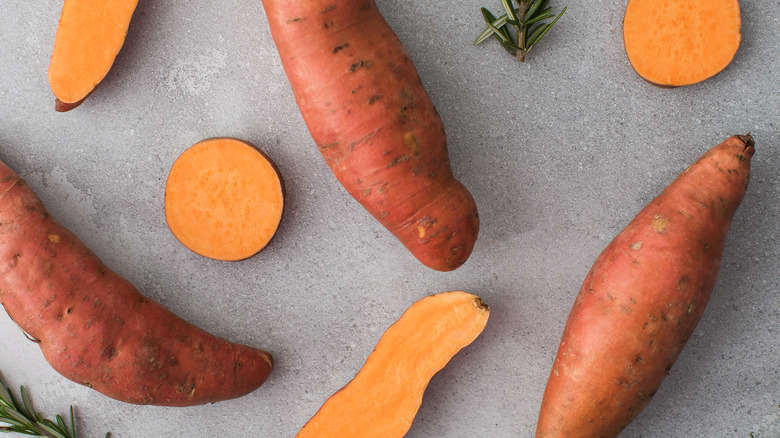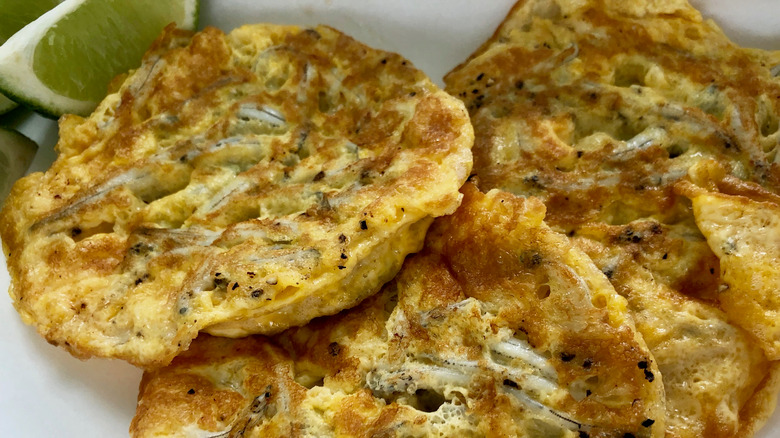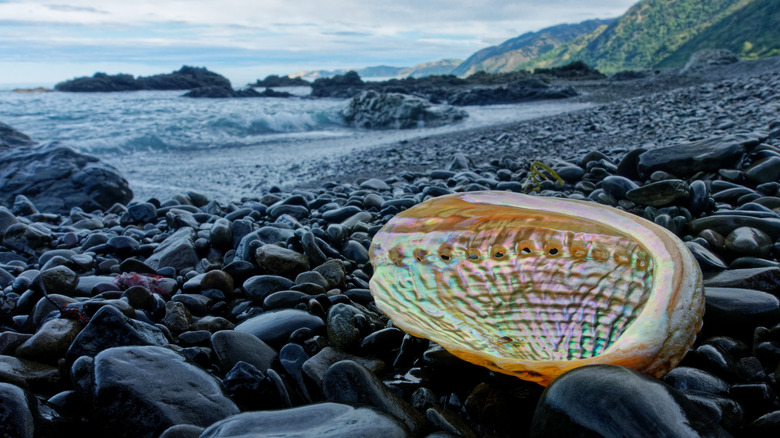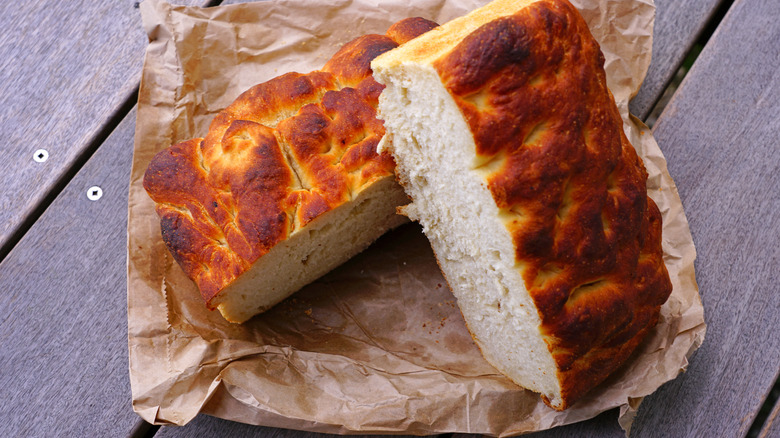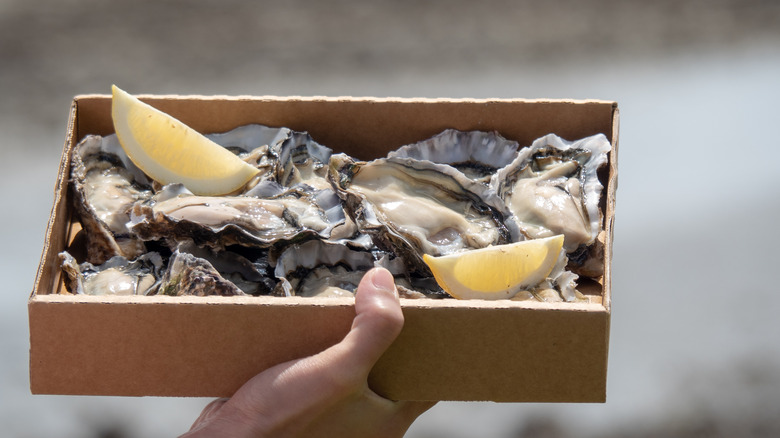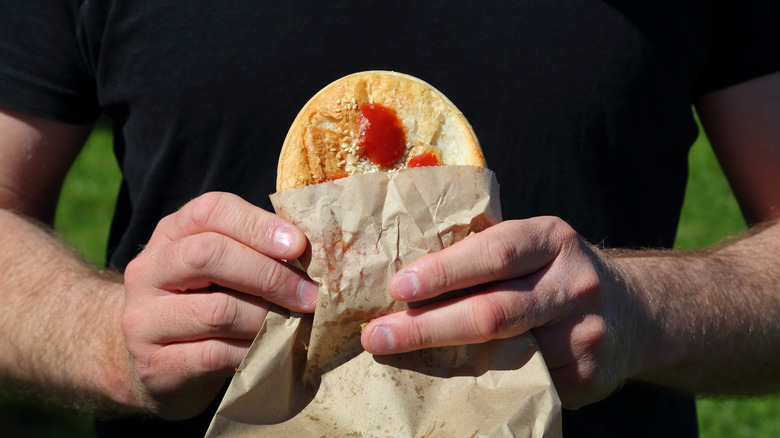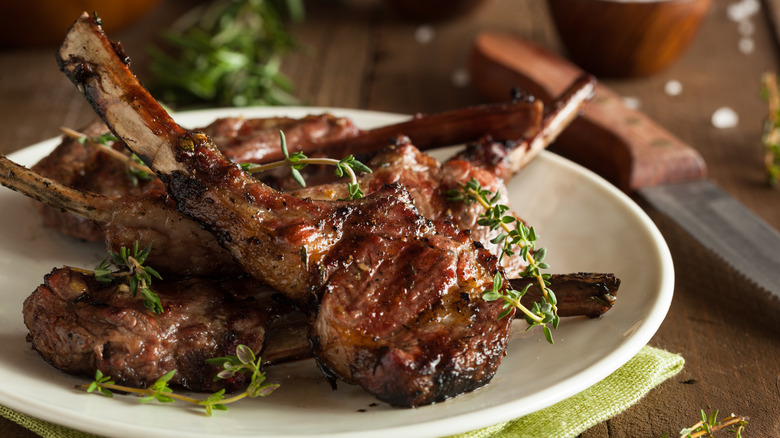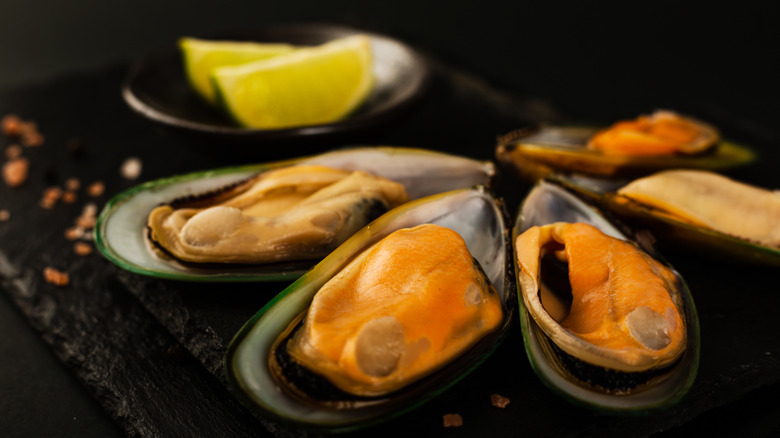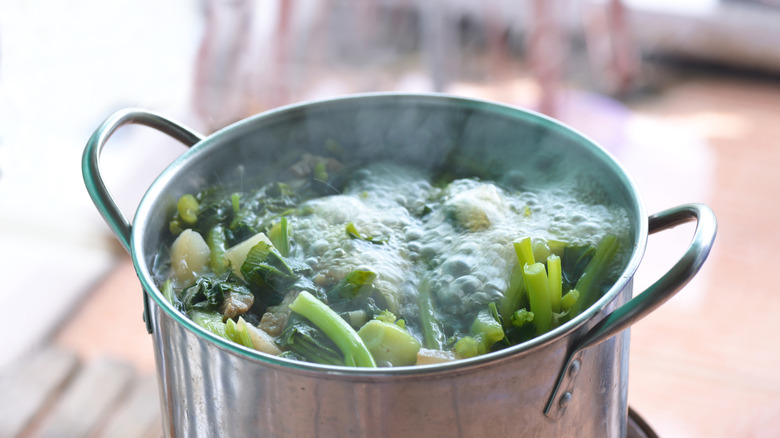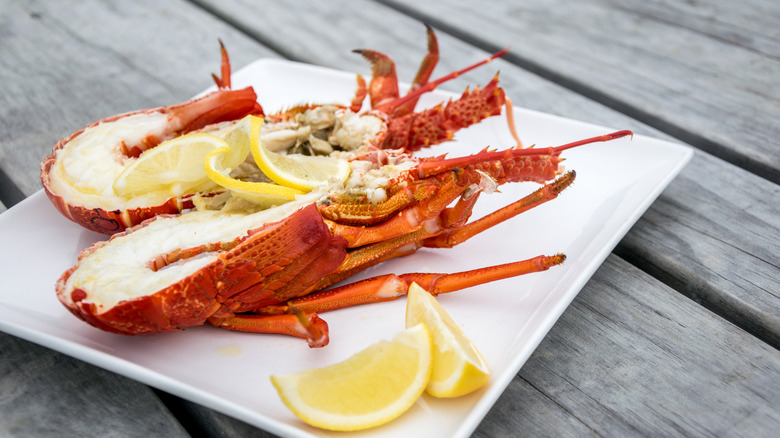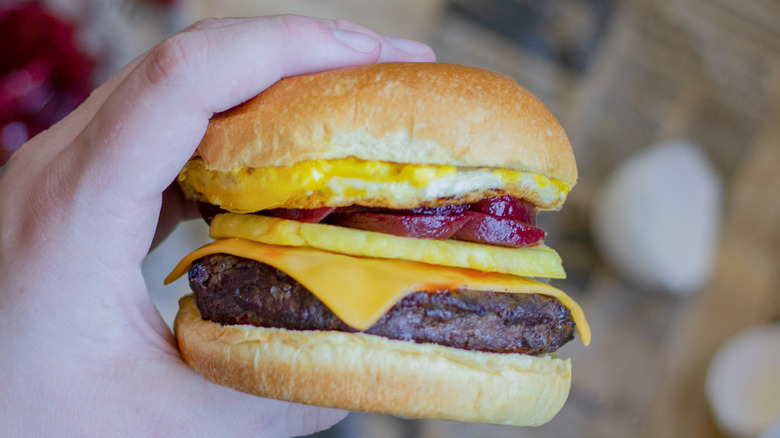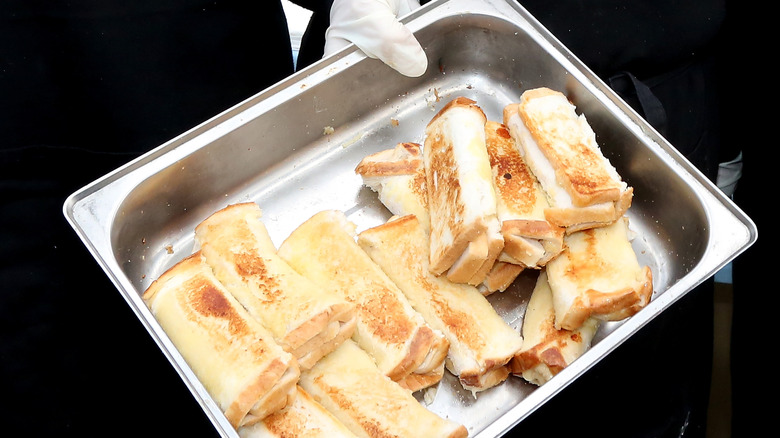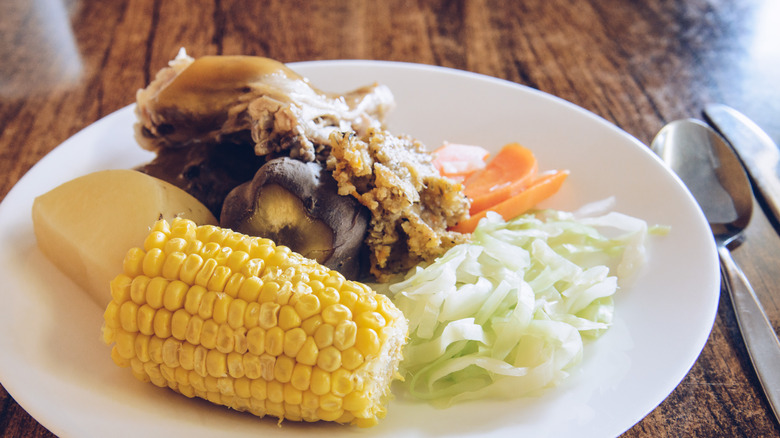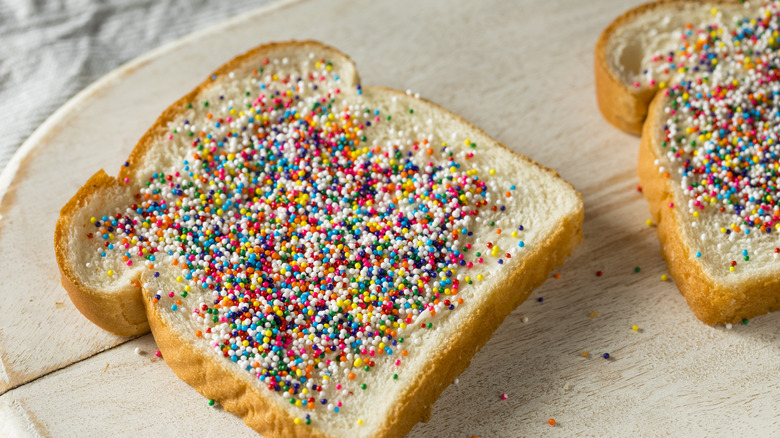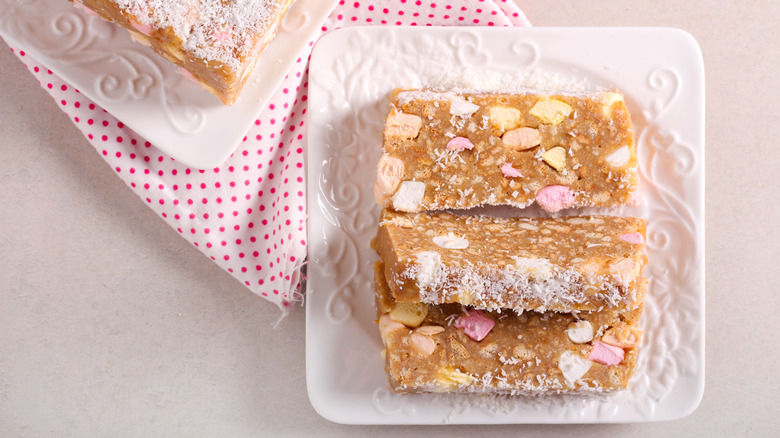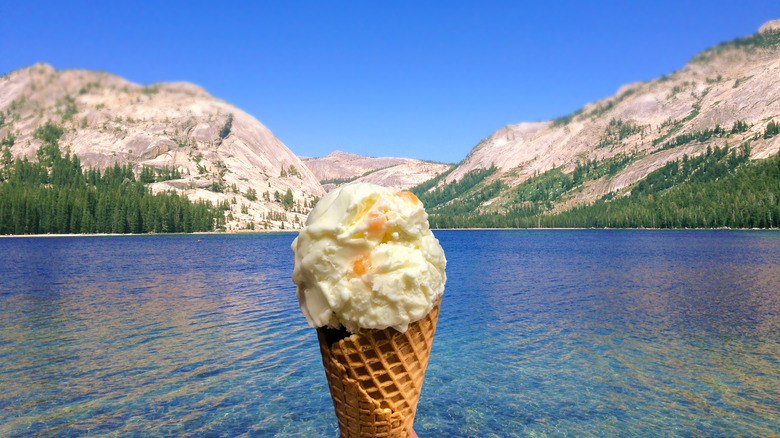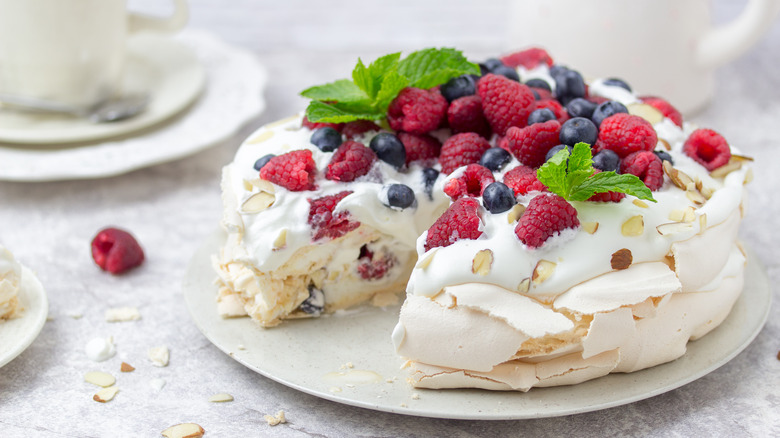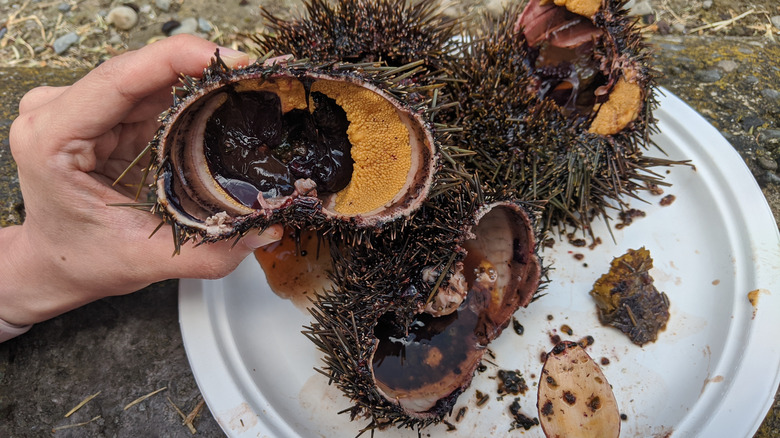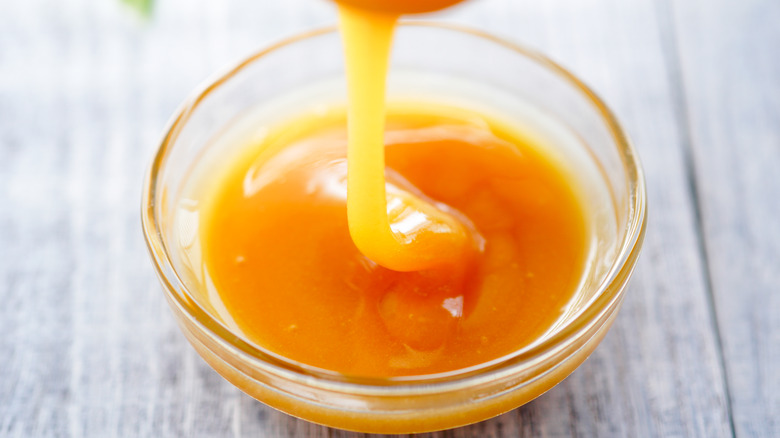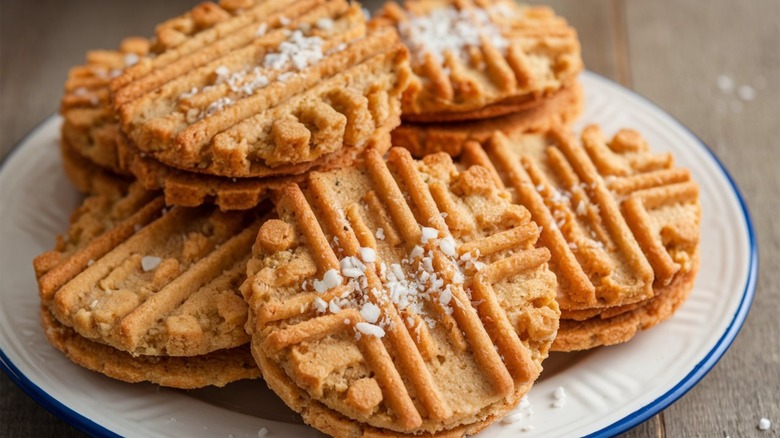21 Traditional Dishes Of New Zealand
We may receive a commission on purchases made from links.
New Zealand is a country that's often overlooked when we think about world-class cuisine, likely because the island nation is so remote. While New Zealanders do emigrate, historically, the country has been on the receiving end of immigration and colonization — first by the Māori, later by the British — and therefore many of their traditional dishes don't make it overseas.
The exception is Australia, New Zealand's nearest landmass (still an impressive 2,500 miles away), resulting in a pair of cuisines that share more than a few traditional meals. In fact, debate still rages over the origin of certain foods, with each country asserting they invented them first; Australia even claims New Zealand's national dish is their own invention. However, the seafood-heavy Māori influence is what sets the latter apart, generating a highly varied culinary repertoire that Australia struggles to match. With that in mind, let's take a look at some of the best traditional dishes New Zealand has to offer.
1. Fish and chips
The first dish most New Zealanders would claim represents their country is the classic fish and chips, or as the Kiwis say, "fush and chups." The origin of this staple takeaway meal is almost certainly Great Britain, where the tradition of eating fish on a Friday due to religious reasons boosted the meal's ranking in British cuisine. Interestingly, the idea of battering fish most likely came to Britain from Western Sephardic Jewish immigrants in the 17th century, who used a batter of water and flour to increase its shelf-life.
While the idea of eating fish for religious reasons may have faded into relative obscurity, fish and chips has remained a New Zealand favorite for decades. However, whereas the British mainly use cod, haddock, or plaice for the fish component of the dish, New Zealanders are more likely to use tarahiki, hoki, red cod, blue warehou, or elephant fish.
2. Kumara
Although kumara is technically one type of food and not an entire meal, it's impossible to compile a list of New Zealand's traditional dishes without including the ubiquitous vegetable. To the rest of the world, a kumara is simply a sweet potato, but this tuber has great cultural significance to New Zealand's early settlers. There's a consensus on the origin of kumara in New Zealand – many claim the first Polynesian settlers introduced it around the 13th century, having brought it with them from South America and proving historic contact between the two distant continents. Modern research indicates it's possible kumara made its way across the Pacific without human intervention but the fact remains that it's been a staple food in New Zealand for centuries.
Most commonly found in four varieties – red, gold, orange, and purple — of varying sweetness and texture, kumara is hugely versatile and used in salads, curries, and stews, or cut into fries and wedges. For a cuisine that's not always vegetarian-friendly, the kumara is a popular component in meat-free dishes.
3. Whitebait
Whitebait is another traditional Māori food that became a favorite with European settlers and has only grown in popularity over the years. Whitebait is the collective name for juvenile fish, and in New Zealand, it specifically applies to five galaxiid species that live as adults in freshwater streams and rivers. However, the juveniles begin their journey at sea and are usually caught on their journey back to their freshwater habitats.
Unfortunately, overfishing has meant four of New Zealand's five whitebait species are now listed as endangered. The environmental degradation of the country's waterways has also had a significant impact on whitebait numbers, forcing the government to regulate how and when people can catch them and making whitebait New Zealand's most expensive fish. Whitebait are traditionally made into fritters by frying them with eggs which are eaten on their own, on toast, or in a sandwich.
4. Pāua
Pāua is the Māori name for a large edible sea snail, known in the rest of the world as abalone. Initially, European settlers avoided eating pāua, instead preferring to collect the mollusks' beautiful pearlescent shells for jewelry making. This likely suited the Māori just fine, as they consider pāua to be "taonga," a word that roughly translates to mean "cultural treasure," but without a direct English translation.
However, in time the Europeans also came to see pāua as a delicacy, putting it in the same precarious position as whitebait. Collecting pāua comes with severe restrictions – they can only be harvested by free diving and recreational collectors can take no more than 10 per day. Unfortunately, the international appetite for abalone also means they are frequently poached from New Zealand and illegally distributed around the world. Pāua can be eaten in a variety of ways — some people eat them raw, but they're commonly made into fritters like whitebait, steamed, or stewed.
5. Rēwena bread
Rēwena bread — parāoa rēwena in the Māori language — is a form of sourdough bread with strong ties to traditional Māori culture. Like other sourdoughs, rēwena is leavened with a fermenting starter; however, in this case, a unique potato-based starter, called a "bug," is used. A bug can be made days before the bread is baked and like other starters, can be kept alive indefinitely as long as the yeast is fed. In fact, some Māori families pass bugs on from one generation to the next, treating it as a treasured heirloom and piece of their history.
Rēwena bread is commonly eaten with butter, honey, or jam, although it's also frequently eaten as a side to soup, stews, and even pāua. The bread's potato content is what sets rēwena's flavor apart from other sourdoughs as it contains a hint of sweetness, which can even be boosted by using kumara instead of ordinary potatoes.
6. Bluff oysters
New Zealand is home to both Pacific and Bluff oysters, although it's the latter that have gained international fame and are most closely associated with the seafood-loving nation. Bluff oysters have been harvested in the Foveaux Strait in the very south of New Zealand for more than 100 years and gained their name from the town of Bluff, a settlement that owes its existence and growth to the oystering industry.
Bluff oysters are only harvestable between March and August each year and, like a number of other entries in this article, are subject to several restrictions to protect stocks. However, it's not just Bluff oysters' rarity that makes them highly sought after — they're widely considered to be the world's best-tasting oysters, known for their plump and creamy texture and intense minerality.
7. Meat pie
The meat pie is another traditional dish that's seen as part of both the Australian and New Zealand national identities; however, in this instance, neither claim to have invented the meat pie. Instead, the debate tends to focus on which nation loves meat pies the most.
Meat pies arrived in New Zealand with the British, who were introduced to them by the ancient Romans and kept munching away at them ever since. In turn, New Zealanders proceeded to get pretty inventive with their fillings, creating classics like steak and cheese or mince and vegetables. They've even taken inspiration from other cuisines, with fillings like Thai green curry or Indian butter chicken. However, the most important feature of the meat pie is its portability — every Kiwi knows the best pies need to fit into your hand for snacking on the go.
8. Lamb
While New Zealand's sheep-to-human ratio is at its lowest in nearly 200 years, it's still the highest in the world, with just over five sheep per person. The vast majority of the country's sheep meat — more than 90% — is exported around the world but that still leaves plenty for Kiwis to enjoy.
Historically, the most popular traditional lamb dish was invented by early colonial settlers and somewhat confusingly called "colonial goose." Back home, it was common to eat goose at Christmas but the birds were rare in New Zealand. With lamb being in no short supply, the inventive settlers instead stuffed a deboned leg of lamb with dried apricots and honey along with herbs and stuffing, before marinating the meat in red wine and then cooking. The result looked somewhat goose-like; hence the name. Although colonial goose is not as popular as it used to be, New Zealanders still regularly enjoy lamb dishes in many forms.
9. Green-lipped muscles
Green-lipped mussels — named for the green hue around the edge of the shell — are another traditional Māori staple, conventionally eaten alongside puha, a slightly bitter, green vegetable. Nowadays, these mussels are farmed around New Zealand and are seen as a hugely valuable commodity for export, with extremely strict quality controls.
In the last few decades, demand for green-lipped mussels has rocketed thanks to the discovery of the mollusks' high omega-3 fatty acid content. Believed to have extremely effective anti-inflammatory properties, many people now use green-lipped mussels as a dietary supplement to combat joint inflammation and arthritis. However, while it's true these mussels contain anti-inflammatory nutrients, there's not yet a scientific consensus as to their effectiveness at fighting specific illnesses.
10. Boil up
The Māori "boil up" is a traditional cooking method that involves boiling a combination of bones and meat — commonly pork — along with vegetables like puha and starchy additions such as kumara and corn. The ingredients are boiled together in a single pot with flour dumplings, known as "doughboys," added at the end to bring the meal together.
Interestingly, while the boil up is traditionally Māori, it only came about after European settlers made it to New Zealand due to a lack of available cooking equipment. Up until the mid-19th century, Polynesian cooks were limited to using wooden bowls, often dropping a heated stone into them to boil the water. With the settlers, however, came portable cast iron pots and cauldrons that could be used to make boil ups and bake rēwena bread.
11. Crayfish
New Zealand crayfish, two species of rock lobster unique to the country, are a delicacy in New Zealand and are known for their meatiness and subtle sweetness. The flavor is delicate, so it's best to ditch any overpowering sauces that might ruin the crayfish's taste, and they're usually eaten with your fingers, straight from the shell.
You'll find the best crayfish in New Zealand in the coastal town of Kaikoura on the east coast of the south island. "Koura" is the Māori word for crayfish, and the town actually gets its name from the tasty crustacean, with Kaikoura meaning "meal of crayfish" or "to eat crayfish." Like lobster in the rest of the world, crayfish are still pretty expensive, so they're seen as a rare treat by most.
12. Kiwi burger
New Zealanders love burgers as much as the rest of the world, although their national twist on a classic might not be to everyone's liking. At first glance, the Kiwi burger looks just like a regular cheeseburger, consisting of a beef patty, cheese, lettuce, grilled onions, mustard, and ketchup sandwiched between a toasted bun. However, look a little closer and you'll see those Kiwis have snuck a fried egg and a slice of beetroot in as well. The combination works better than you might think, but we can see why it might be a little off-putting to first-timers, especially as some New Zealanders also consider a slice of pineapple a compulsory ingredient in their Kiwi burger.
While the Kiwi burger has yet to find a foothold outside of New Zealand and Australia — some might consider that a blessing — its popularity among Kiwis was enough for the country's McDonald's restaurants to add it to their menu all the way back in 1991. Unfortunately for egg and beetroot burger lovers, the company delisted the Kiwi burger as a permanent menu fixture, but it still pops up from time to time as a limited release.
13. Cheese rolls
Known colloquially as "southern sushi," a name that's possibly more ironic than it is accurate, cheese rolls are a dish associated with the southernmost region of New Zealand. In its simplest form, a cheese roll is a slice of white bread covered in grated cheese, rolled into a tube, and toasted. However, you're more likely to encounter more complex variants of the cheese roll, with most versions being closer in comparison to Welsh rarebit, featuring mustard powder and Worcestershire sauce.
Cheese rolls will normally contain onion pieces or onion powder, and some people coat their rolls in a sauce of unsweetened evaporated milk before the toasting stage. Truthfully, there's no "right way" to make a cheese roll and most Southlanders you speak to will give you a different recipe based on their personal tastes and, most likely, the style they grew up eating.
14. Hāngī
The hāngī is the most famous traditional Māori method of cooking food and makes use of an underground pit oven, an ancient style of cooking that can be found in many different forms across the world. In New Zealand, the oven itself is called an "umu" and the process starts with digging a pit deep and wide enough to contain a fire and the cooking ingredients, but not so deep it's hard to retrieve the food once it's done.
Once a pit has been dug, a fire is built and covered with large stones. It's important to note that only volcanic rock — fortunately extremely common in the region — is used thanks to its heat-holding properties. After three to five hours, the wood should be burned down and the stones white hot, so metal baskets of food can be placed on top of the hot rocks. Finally, the food is covered with wet, fireproof sheets or sacks to allow steam to form, and the pit is carefully covered with dirt and left for around three hours, with any escaping steam patched throughout. While the contents of a hāngī can vary, the most common ingredients are seasoned meat (such as pork or lamb) wrapped in banana leaves and vegetables such as kumara and pumpkin.
15. Fairy bread
Fairy bread is a children's birthday party staple in New Zealand — one that most non-Kiwis are surprised has continued to be so popular. Also a favorite in Australia, which is the likely origin of the famous snack, fairy bread was first recorded in the 1920s when it was listed as a treat enjoyed at a party for child patients at a tuberculosis sanatorium.
While the name may be intriguing — appealing, even — fairy bread is just a slice of plain white bread, covered with butter, and sprinkled with colorful 100s and 1000s. Some fairy bread fanatics insist that margarine is better than butter, and most will agree that cheap, white, store-bought bread is the only way to go. Basically, the unhealthier the fairy bread, the better.
16. Lolly cake
Another birthday party favorite in New Zealand is the lolly cake, sometimes known as a lolly log. For the uninitiated, New Zealanders use the word lolly to refer to all candy that isn't a chocolate bar, and in lolly cake's case, they'll use Fruit Puffs, a type of firm, fruity marshmallow.
Inexpensive and simple to create, a lolly cake is made by mixing together melted butter, condensed milk, crushed malt biscuits, and chopped Fruit Puffs. The resulting dough — for want of a better word — is then formed into a log or loaf shape and rolled in desiccated coconut before being tightly wrapped in saran wrap or baking paper and refrigerated. Once it's nice and firm, the super sweet log is cut into slices for serving.
17. Hokey Pokey ice cream
Hokey pokey is a name that's been associated with ice cream since the late 19th century when it first became accessible to the masses in the U.K. and Europe. The origin of the name is still debated, although it's generally accepted to be an Anglicized version of "O che poco," the Italian phrase for "Oh, how little!" that was regularly called out by street sellers. Let's just say that if you did treat yourself to hokey pokey, there's a good chance you're going to spend the rest of the day in the bathroom. What did you expect from Victorian-era street ice cream?
In New Zealand, however, the name hokey pokey came to be associated with one flavor of ice cream in particular: vanilla with honeycomb toffee pieces. To say hokey pokey ice cream is popular in New Zealand would be somewhat of an understatement, with it frequently topping the lists as one of the highest-selling ice cream flavors in the country.
18. Pavlova
Saving the best for last, pavlova is generally accepted to be New Zealand's national dish, something that makes the fact Australia claim to have invented the dessert a point of contention. A meringue base covered in fresh cream and sliced fruit, the pavlova was named after the world-famous Russian prima ballerina, Anna Pavlova, when she visited the region in the 1920s. While Australians and New Zealanders both lay claim to the dessert, they do agree on the last point.
Fortunately for the Kiwis, the Oxford English Dictionary announced in 2010 that the earliest New Zealand recipes for pavlova appeared in the 1920s, whereas they didn't start appearing in Australian cookbooks until the 1940s. So, that must have settled the debate once and for all, right? New Zealanders certainly think so, but the Australians? Not so much.
19. Kina (sea urchin)
Kina is the New Zealand name for sea urchin. You know, those spiky sea creatures that resemble a hedgehog? They may not look edible but the centers are actually lined with thin, fleshy meat. Seafood is a huge part of New Zealand food culture, so you're bound to find lots of it in their culinary repertoire, but Kina is considered a delicacy and has been for centuries.It is a traditional Māori food and it is loved for its unique taste and versatility. The flavor is oceanic as a whole but it has sweet, briny, and creamy elements — many describe it as a combination of all different kinds of seafood.
Due to Kina's unique flavor and versatility, it can be eaten raw or cooked, and you'll find it paired with many cuisines in New Zealand. It is especially revered in sushi, but creaming, battering, pureeing, frying, and smoking Kina is also common, so there's nearly endless ways to enjoy it. While some say it is an acquired taste, it is definitely worth a try, even if you don't opt to enjoy it raw straight from the shell, as it is often consumed in New Zealand.
20. Mānuka honey
Mānuka honey is an ingredient, not a specific dish, but it is undeniably a big part of New Zealand food culture. In fact, it is believed to be the first honey ever produced in the country. Mānuka honey is harvested from bees that pollinate New Zealand's Mānuka trees, which are known for their medicinal properties. While the history of the Mānuka trees dates back to the country's first settlers, the honey didn't become a thing until the European Honey Bee was introduced to the land in 1839.
Unlike most types of honey you find in the United States, Mānuka honey contains high levels of methylglyoxal. As a result, it is exceptionally nutritious and also works as an antibacterial agent. It can be used to help close wounds, soothe a cough, aid in digestion, promote oral health, and more. It is also a recognized antioxidant and anti-inflammatory ingredient. Pretty cool, right? When buying Mānuka honey, you want to look for the Unique Manuka Factor (UMF) quality trademark. It tells you how pure and potent a specific product is. The higher the number, the more expensive it will be, but many say it's worth it for the medicinal benefits it provides.
You can buy MGO 50+ blended (multifloral) Mānuka honey, which is not considered pure, for a reduced price. Regardless of what grade you opt for, Mānuka honey is a splurge-worthy grocery store item you need to try.
21. Anzac biscuits
Anzac biscuits are wildly popular in both Australia and New Zealand, and unlike other foods, the two countries gladly share the credit for the development of this tasty treat. Anzac biscuits are delicious oat and coconut cookies with a rich buttery, sweet taste and they can be made crunchy or chewy. Either way, people love them. Unique from other types of cookies, Anzac biscuits don't contain eggs. Instead, a golden syrup is used to bind the ingredients together. This not only leads to a richer taste but also elongates the biscuit's shelf life.
Legend has it that Anzac biscuits were first created during World War I and were sent to troops abroad. Actually, the term Anzac is an acronym referring to the Australian and New Zealand Army Corps, and they are still made today on Anzac Day — New Zealand's version of Veterans Day. Since it was first invented, the Anzac cookie recipe has experienced many changes, but the recipe people have come to know and love is thought to have originated in 1920. Considering the recipe's century-old origin and continued popularity, there's no doubt that they are a tasty New Zealand food you should try at least once.

